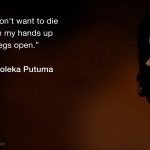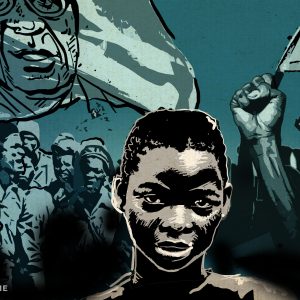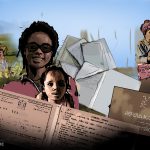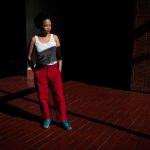Nobody, the place where everybody knows my name
Tracing the origins of her ancestors in South Africa, the Zimbabwe-born writer tells the story of the borders – real and artificial – she crossed on her journey home.
Author:
20 May 2020

The first week of September 2019, in which former Zimbabwean president Robert Mugabe died, was one of chaos. In South Africa, we were mourning the brutal assault and murder of University of Cape Town student Uyinene Mrwetyana, a tragic story that resurrected the vivid fear of living as a woman in this country. The post office where she died was just down the road from my house and I used to frequent it.
It was also during that same week that xenophobic violence in Johannesburg escalated once again, with images of hoards of South African men taking to the streets of the central business district armed with machetes, threatening to kill Zimbabweans, Nigerians and other migrants. It was a very difficult moment, being at once Zimbabwean and a woman.
Related article:
I had no room in my heart to mourn the dictator’s death, lodged as I was between fear and grief at this intersection of my identity, which made me feel extremely vulnerable. Where do I call home: the place I had to leave or the one I had to come to, but where I live with the expectation of a brutal death? South Africa, to me, as anyone can tell from my name, is home in more ways than one.
Early memories
My grandmother was called MaNdimande. A tall, voluptuous and dark Zulu woman, she lived with her cousin and companion, MaKhambula, with whom she and other family members shared a small five-room house in Rimuka, Kadoma, about 140km south of Harare. Because MaKhambula was quite obese, she never left her room. So my grandmother spent the day on her couch, with her green and orange handbag that contained her knitting, gossiping with MaKhambula across rooms, shouting “Kazini!” and holding forth in isiZulu, which was unintelligible to me.
MaNdimande sold a popular frozen juice, coloured and sugary, known as “freezits” or “frozen” in Rimuka. This is why I loved to visit: the unending supply of freezits and the free movement of the township were incomparable to the lonely life of suburban Marlborough, northern Harare, where I grew up. I can still see MaNdimande’s dark skin, the moles on her face and her high cheekbones. When she walked, her rounded bottom and generous hips swayed from side to side. When she sang – always in isiZulu or isiXhosa – it was the most beautiful and haunting thing I had ever heard:
Amagugu, alelizwe ayosal’emathuneni
Amagugu alelizwe ayosal’emathuneni
Ngiyosala ngingedwa ethuneni lami
Ngiyosala ngingedwa ethuneni lami
On Sundays she dressed up for church in the uniform of her childhood church, the American Methodist Episcopal, also known as Topia in South Africa, with a leopard print hat for a stellar finish. Her husband Jacob, having been educated at Waddilove, a Methodist mission school in Marondera, had allowed her to leave the Dutch Reformed Church of the Basotho community into which she had been married and go back to her former church. Every Sunday, as I go about my business, wherever I am in South Africa and see women in this same uniform, I smile a little to myself as I remember MaNdimande and how she proudly donned her favourite outfit.
My mother worked with the Zimbabwe School Examination Council, where she coordinated the marking of exams. Her job required frequent meetings in Kadoma, and my sister and I would head there with her at the beginning of the holidays. My mother would leave us in the care of my grandmother while she worked and pick us up a week or so later. It was a township like any other: pit latrines, cramped living quarters and barely any water or consistent electricity. But for us it was an adventure and a place filled with love, a generous supply of masau (the slightly sour fruit which is abundant in northern Zimbabwe) and my grandmother’s singing.
Being different
Another pleasure was the family gatherings where my father and his siblings would speak their language, Sesotho, in loud and excited tones, as if they had been holding it in for too long and could finally let it out. There was always prayer time. My grandmother would put her big rimmed spectacles on and reverently read from her Sesotho Bible. In the dim light, with all her children and grandchildren surrounding her, she would eloquently preach with a soft and quivering voice. And then we would all sing a hymn. This, we had all learnt:
Haufi le Morena – haufinyana
Le ha sefapano – se ka ntlisa
Ke ntse ke fiela
Ho ba, haufinyana
Le Morena
It was a strange, mixed, warm and complicated feeling understanding my heritage and enjoying its uniqueness, and singing Sesotho hymns in a Zimbabwean township in which Shona and Chewa were the most spoken languages. However, it is this same difference that I hated, or rather, dreaded: growing up in Harare, Mashonaland, in a country not tolerant to difference.
I was born in 1987, the last year of the Gukurahundi, the genocidal war waged by Mugabe’s Fifth Brigade against the Ndebele people in the Matabeleland and Midlands provinces. Being different in a Shona-dominated community was not easy. Malawians were called “mabwidi,” or “maBrandaya”, a bastardisation of the word Blantyre, the commercial capital of Malawi. In the 2000s, Mugabe would describe people of Malawian, Mozambican and Zambian origins as totemless, the worst possible insult for the Shona.
Related article:
It took weird looks and giggles to learn that not everyone referred to their brothers as “buti”, their father’s sister as “rakgadi” and their grandmother as “koko”. Teachers, never bothering to learn my name, opted for the easier middle name Rachel, or deliberately butchered Lebohang to garner laughter from the rest of the class. By the time I was 10 years old, I had closed myself off to the language and heritage my father was so proud of and determined to teach us. I wanted a Shona name, to speak only English and Shona, and be like everyone else around me.
Eater of hearts
One of my favourite stories from my childhood is my origin story, the one which explains where our surname Mojapelo comes from. My father told us that our ancestor was an avid hunter, one of the most well-known in his village up in the mountains of Lesotho. According to tradition, every animal that was killed in the kingdom had to be brought to the king’s court and the heart of the animal presented to the royal. No one in the kingdom other than the king was allowed to eat the heart, “pelo”, of any wild animal.
However, my hunter ancestor really detested this culture. After all, as the hunter, should he not be the sole owner of the entire carcass of the animals he killed? Remember, hunting took days of patiently tracking animals in the wild and the very strategic setting of traps and, eventually, the highly skilled shooting of arrows or stabbing using a spear. One day, he secretly went hunting and killed a wild animal. He went home and, in secret, carved out the heart and ate it himself. Of course, he was particularly curious how it would taste.
Somehow, perhaps through the very same magical power for which he needed the heart of every animal in order to sustain it, the king knew of this betrayal. He called the great ancestor to his court, demanding to know if he had eaten the heart of a wild animal he had hunted and killed. Clearly shocked by this discovery and in fear, my ancestor immediately confessed his sin. The whole kingdom was in shock and awe of this daring man, and from that point forth he became known as Mojapelo, the eater of hearts.
Maternal origins
“Nquthu, Dundee, Ladysmith …” My maternal grandmother’s father, Charles Ndimande, had taught his daughters and niece, MaKhambula (the daughter of his wife’s brother), the names of the stations so that they would know where to get off when he came to pick them up and take them to their new home in Rhodesia. Ndimande, from the village of Hlazakazi near Nquthu in KwaZulu-Natal, had initially travelled to Southern Rhodesia (Zimbabwe) with Cecil John Rhodes’s Pioneer Column in 1890 as a cart driver. He was an expert with mules. Later he would work with the postal service and transport goods between Harare, Masvingo, Beitbridge and Cape Town. This was considered a prestigious job for black people and it paid well; it is the subject of the mbira classic Chemutengure.
Related article:
He married MaKhambula (not to be mistaken with his niece, who, as a woman of the same family, would bear the same name as her aunt) in his hometown. When his family eventually joined him in Rhodesia, they, along with a group of Xhosa and fellow Zulu settlers, made homes in Marirangwe in Mhondoro, near Salisbury (now Harare). Others settled in Lower Gwelo (now Gweru) and in Mbembezi, where isiXhosa is still spoken. For this reason, it is common to find Nguni surnames like Tutani, Faku, Magwaza and so forth in Zimbabwe. It is said that when they settled here, near the river, they would go to umfula (“river” in isiZulu) to wash clothes and bathe, as everyone did. Because the Shona tongue does not have the consonant “l,” the locals began to call the river “Mupfure”, the name by which it is known today.
After a few more years of travelling, Ndimande went back to his home in Nquthu to sell his donkeys and horses, with the intention of heading back to Southern Rhodesia. Unfortunately, he never went back; his wife and children received news of his death. It is strongly believed that there were many family members who had been eyeing his wealth since he had left Nquthu. His return spoiled their plans and they poisoned him.
Paternal origins
My paternal great-grandfather, Petros Mojapelo, also went from South Africa to Southern Rhodesia as a servant with Rhodes’s Pioneer Column in 1890, with a group of other Basotho. What is distinct about this particular group is that they were Christian converts and served with the white missionaries from the Dutch Reformed Church, which had recruited them to help spread the gospel of Christ. The missionaries thought if they had Africans with them they would be more successful in reaching the Shona people in the area they would settle in: Gutu, in the province of Victoria (now Masvingo). Petros married a fellow Sotho woman, Elsie Rasetla, who had two children already. The two went on to have two more children, Michael and my grandfather Jacob.
The Basotho first lived in the town of Fort Victoria (now Masvingo), which they assisted in building and called Boikhutso, before eventually settling in Masema in Gutu district. Here they lived among the Shona and proceeded with their mission of preaching the Christian gospel and converting locals. The Basotho lived communally, married among themselves, shared resources and built their own schools, churches, graveyards and many other institutions. Nearby, one of the first printing presses in Zimbabwe was built at Morgenster Mission. Bibles were printed here and it later became one of the biggest educational institutions in Masvingo set up by the Dutch Reformed Church.
The Basotho were distinct from the local Shona, who had been dispossessed of their land. They were allowed to purchase land with the money they earned from working with the missionaries and white settlers. (At this point, Southern Rhodesia was still considered a province of South Africa; in 1922-1923 the British in South Africa voted in a referendum to make it a separate colony.) The Basotho were also allowed to own firearms, unlike the Shona. Therefore, my grandfather Jacob, also known as Japi, would occasionally be called on by the Shona in surrounding areas to come and kill a wild animal – mainly lions and leopards – found in the vicinity.
After both Petros and Ndimande passed away, a mutual family friend, Mokhetse, suggested to Rasetla and Makhambula that they could keep each other company while they raised their children alone. It was by this design that the Ndimandes and the Mojapelos lived together on Rasetla’s farm, and eventually MaNdimande and Jacob became husband and wife. Rasetla bought them the farm where my father and his siblings grew up, just a few miles from his grandmothers, aunts and uncles.
When Jacob decided to take a second wife, life got very complicated for MaNdimande. After prodding from her sister, she decided to leave and move to Kadoma, where she worked as a nursing assistant in a hospital and eventually in the Queen Mary Hospital’s maternity home until she retired. It was at this point that my father and his siblings had to leave the comfort of their Sotho community, which our family had been a part of for three generations.
My father always impresses upon me his knowledge of his roots. He insists that there was always a connection between his family in Rhodesia and in the former Transvaal. Before there were borders, he says, there was free movement between the two spaces that allowed families to visit and move back and forth, and therefore it was not that big of a deal for them to be so far away from each other. Movement became difficult only later on, when borders were erected and policed. The introduction of apartheid made it even worse because the family in Transvaal was no longer allowed to move freely, a fate made worse by the dispossession of their land, which impoverished them.

Face to face with otherness
The first prominent xenophobic attacks in South Africa started on 12 May 2008. At the time, I was a third-year student at the University of the Witwatersrand, which I had been very excited to attend. My connection with South Africa being obvious, I was eager to know more about Sotho culture and fully learn the language. I wanted to experience something of my ancestors, walk on the same landscape they had trod a century ago. Maybe I was expecting a certain belonging that went beyond language: recognition. I enjoyed the feeling of strangers teaching me what my totem is, others letting me know we are neighbours, ekhaya (“at home” in isiXhosa), and even more, enjoying the history lesson I would impart that they would never have learnt anywhere else.
I did not mind being an anomaly: the Zimbabwean South African, or was it the South African Zimbabwean? The Zimbabweans on campus thought I was pretending to be South African while the South Africans thought I was pretending to be Zimbabwean. This in-betweenness lasted only until the locals decided to “take back their country”, and violent attacks and looting targeting foreigners began in Alexandra township and spread across the nearby CBD and other places across South Africa.
We were in shock and panic as our friends tried to teach us how to say “elbow” in isiZulu, just in case we were accosted by those inflicting the violence. A line was effectively drawn then: when it came down to life or death, I did not really belong in this place. Sometimes, even South African natives from Limpopo, where some of my ancestors are from, with darker skin and heavier tongues, were caught up in the orgy.
One episode from 2010, when I was studying for my master’s degree, is instructive. Having travelled to Durban for a few weeks, I came back to an OR Tambo airport teeming with policemen, there to secure the place for the duration of the Soccer World Cup. A friend came to pick me up and, before we could leave, a policeman stopped us and asked for my identification. I handed over my South African identity document with my name, Lebohang Mojapelo, and he immediately became serious. “How can you be Mojapelo and yet it says you’re from Zimbabwe?” It is a question I am used to, but at that moment it seemed threatening.
Related article:
Trying to muster confidence I did not feel, I stated that yes, I am from Zimbabwe but my father’s family is from here, hence the name. The officer refused to believe me and called over other officers to show them my identity document. A few laughed and the others became curious, rather fascinated by my “lie”. I explained again that my document was legitimate and began to give a history lesson that fell on deaf ears as they asked me to accompany them to the police station at the airport. I began to panic, very aware of the brutality of the police, the adverse treatment of foreigners, as well as the deplorable conditions of the detention centre where they take “illegals”, Lindela.
I decided to call my father in England and prayed he would answer. He did. I handed the phone to one of the policemen and my father spoke to him in Sesotho. After the conversation, the policeman seemed even more enraged. “So your father went to Zimbabwe and now he has forgotten how to speak his language? And even you, you speak English and not even your mother tongue. You think you’re special?” But he let me go.
Ties that bind
In 1988, a year after my birth, my parents travelled with me and my three siblings, Kgotso, Leseli and Dikeledi, to Johannesburg to purchase a new car. My brothers were looking through the telephone directory and were surprised to encounter our name, Mojapelo. They confronted my father about why they would find our name in a telephone directory in South Africa and then insisted they call one of the numbers so they can get to know their South African relatives.
Taking a chance, my father called one Christopher Mojapelo, who was so struck by the idea of Mojapelos from Zimbabwe that he immediately drove from Alexandra township to see our family. After a brief talk, Christopher and several other family members decided to throw a party for us, which my mother insists was a rather large celebration, with all our “relatives” eager to meet us and know us. Christopher even gave my father advice about where to get the best vehicles at the best price, and we drove out of South Africa in a brand-new BMW.
Before we left, however, under instructions from our new “relatives”, my parents decided to search for our direct relatives, having been informed the best place to look was in Limpopo. We travelled to Pietersburg (Polokwane), where we were introduced to Morena Lebowa, who directed us to Matibaskraal and eventually to a place called Nobody. But unfortunately, without much information, we did not get to meet any of the relatives who would know us.
Related article:
Two years later, in 1990, my father got a job as a high school maths and science teacher in Mafikeng. When he arrived, the headmistress immediately notified him of possible relatives nearby whom he may be interested in meeting. He was introduced to one Mrs Mojapelo, but she stressed that she had merely married into the Mojapelo family and could only direct him to the home of the Mojapelos in Pietersburg.
My father visited the area of Nobody once again, and this time he was dropped off at the home of my uncle, his cousin Tom Mojapelo. Sceptical, Tom asked my father who his father and grandfather were, and he instantly knew who my father was. Immediately taking him under his wing, Tom insisted that my father live with him and helped him to find a job closer to “home”. He ended up teaching at a few colleges in the area until he settled, for many years, at Khanyisa College.
Discovering another home
I was seven years old the first time I visited my great-grandfather’s home in Nobody. To be in a place where everybody is a Mojapelo, in a place called Nobody, is as ironic as it gets. I was very young but understood the reverence of the occasion. There were many of us – my father’s brothers and sisters and their children. It was a big party and the greater part of the neighbourhood joined to celebrate “the Mojapelos of Zimbabwe”, each of them explaining their branch of the family.
I remember the heat of Limpopo, the dust of Pietersburg and the curious delicacies I tasted for the first time, such as oven-baked scones, biscuits, atchar and beetroot. There was the chatter in Sesotho, which my father and his siblings found to be different to the language they had inherited from their grandfather, and the memories of this man who had left many decades ago but still distinctly existed in the memories of his cousins and uncles.
My uncle Tom related to us: “There was a suitcase in my grandparents’ house when we were growing up. We were not allowed to play with it or even go near it. We were told that it belonged to one of our great-uncles, my grandfather’s brother, who was believed to have taken a journey to Zimbabwe, and they were keeping it for him, as he had asked of them, for when he came back. Although I never met him, this suitcase came to represent this adventurous and mysterious relative we would only know through this suitcase.”
We now had a home, one we were not just told about in the stories of my father’s father and grandfather, but a physical home that would welcome us three generations later. As I grew older and more of the extended family moved to South Africa, my South African relatives consistently held “a re tsebaneng” (let’s get to know each other) parties and gatherings. These have always been so special to me: the curiosity, the connections and the welcoming and accepting love: a belonging. It was the beginning of the journey of our families reconnecting across borders.
This was a useful reconnection that, although we were not aware of it at the time, would help me and the rest of my extended family to claim our legal right to South African citizenship: a way out of Mugabe’s brutal regime and declining economy, the next wave of migration for this Basotho community, this time going back home.
However, the story that lingers unfinished in a pressing way for both me and my father is the one of Charles Ndimande, the other branch of the family in KwaZulu-Natal. We have not been able to trace it nor have we ever met someone, even by chance, who has known him or of him. My brother has traced the railway line that MaNdimande taught my father and his siblings about and we hope to go there one day. I do not know what or who we will find, but if we can find Nobody, surely we can find another family and another home in Hlazakazi village near Nquthu.





